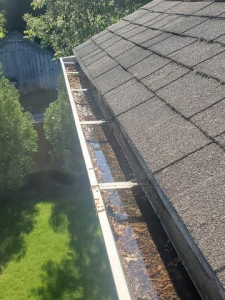Gutter Solutions channel rainwater away from your home, reducing the likelihood of water damage and other issues. They also offer protection for your landscaping and garden areas.
Gutter Solutions offers a range of innovative gutter improvements, including gutter guards and leaf screens. They also provide expert installation to ensure a seamless, functional gutter system. Contact Charleston Gutter Solutions now!

Many homeowners see gutters as a purely functional component of their home, but in the hands of experienced professionals, these systems can become an integral part of a home’s design aesthetic. Choosing high-quality materials, adding stylish accents, and ensuring consistent maintenance can elevate the appearance of gutter solutions beyond their basic utility, transforming them into a sophisticated design element that complements a house’s architecture and amplify its visual harmony.
Gutter solutions that are built for the aesthetic demands of modern homes can enhance their overall beauty and add a higher resale value. Seamless gutters, for example, seamlessly blend into a property’s exterior and eliminate unsightly seams and leakage points. They also withstand the harsh weather conditions of Rochester’s climate, making them an ideal choice for homeowners who want to maximize the efficiency and functionality of their water drainage system without sacrificing style.
Aesthetic elements like decorative covers, rain chains, and gutter gardens are also available for homeowners who wish to take their gutter solution’s aesthetics a step further. These accessories can transform gutters into a statement piece, complementing a building’s architectural features and creating a unique design that elevates the curb appeal of a home or commercial space. For residences with historical significance, bespoke gutter accents can be crafted to reflect the home’s heritage and character, highlighting these unique features and elevating them into a significant design feature.
Innovative gutter solutions also minimize the need for manual maintenance by preventing clogging and deterioration. Seamless gutters, for example, are custom-fitted on-site before installation, allowing builders to ensure that each section is perfectly tailored to the size and shape of a structure’s eaves, avoiding the patchwork effect that occurs with traditional sectional gutters. In addition, gutter solutions that rely on advanced technology, such as gutter guards and leaf protection systems, can eliminate the need for homeowners to climb ladders and manually clean their gutters, saving them time and reducing the risk of injury.
Drainage
Drainage issues are a common cause of cracked foundations, basement leaks, and landscape erosion. Often these problems can be prevented with proper gutter drainage and regular maintenance. Our team of experienced professionals will evaluate your home’s drainage needs and recommend the best solution for your situation.
Gutter Solutions installs a variety of gutter and downspout drainage systems to keep your home safe from water damage. We can also provide the services you need to maintain your current system such as clog removal and downspout extension.
Clogged gutters trap moisture against roof shingles, which can cause wood rot and lifting shingles over time. This can lead to costly structural damage to your house and other parts of your property. Regular gutter cleaning keeps water flowing properly and diverts it away from your home’s foundation.
Depending on your location, you may need to take more drastic measures to ensure your gutters drain properly. Some options include:
A corrugated pipe capped with a rainwater emitter redirects gutter runoff to a storm drain or dry well. This option can be installed underground and is perfect for locations with a sloped yard. Gutter Solutions installed this solution for one of our customers who had an issue with their neighbor’s downspouts flooding their backyard. The buried corrugated pipes collect and disperse the runoff so it waters their landscaping evenly.
Another solution is a french drain, which is an underground drainage tank that is surrounded by gravel and has a grate and vertical pipe leading to an existing drainage system. This is a great solution for properties with low elevations or those with high groundwater levels.
For extreme cases where your gutters are not draining at all or have a lot of standing water near your foundation, you may need to have your yard regraded. Landscaping professionals can redefine the contours of your yard with a bulldozer to redirect water flow and make sure that your gutters are not overflowing or pooling.
Safety
Gutter solutions provide a key role in directing water flow away from your home, protecting its foundation and structural integrity for years to come. However, gutters can easily become clogged with debris and silt, impeding their functionality. This often results in water overflow and run-off, damaging the exterior of your property. Over time, this can also soften the soil around your foundation, exposing your property to unsettling and costly structural damage.
Gutter cleaning is not an easy task to undertake, especially if you don’t have the proper gear and equipment. Choosing the right ladder is fundamental, as you’ll want to ensure that it is rated for your weight and that it has adequate stability. Additionally, working with a buddy makes the entire process safer, giving you a sense of security and allowing you to clean your gutters much more quickly.
Protective eyewear is also a must. Working with dirty, rotting leaf debris and bird, pigeon, and squirrel feces can expose your hands to dangerous bacteria. Additionally, working with metal shards can be extremely hazardous. Gloves can help protect your fingers and hands from these hazards.
Lastly, you’ll want to ensure that your workspace is free of potential dangers, including uneven terrain and overhead electrical wires. Choosing a day that’s free of these risks can significantly reduce your risk of injury or damage to your gutters during the installation process.
While you can make numerous safety considerations during your gutter installation project, sometimes the intricacies of this type of work call for specialized expertise and rigorous dedication to safety protocols. For this reason, it’s important to recognize when you need professional assistance. Professional gutter installers can bring valuable experience, specialized tools, and a commitment to safety to your project, ensuring that it’s completed with the utmost efficiency and effectiveness. Moreover, they can assess your unique needs and recommend the best gutter solution to ensure optimal functionality. Contact Scott Bauer Roofing for a gutter solution tailored to your home’s needs. Our team of experts is always happy to assist!
Maintenance
A home is not only a place to live, but it’s also an investment that must be safeguarded. One of the ways to do this is by managing the flow of water through gutter solutions. The right solution will prevent a slew of issues, from structural damage to mold and mildew growth, that can impact health and safety. A reputable company will understand that every house is different and will design a customized solution that fits your needs, ensuring optimum functionality.
Gutter leaks and clogs can undermine the function of gutters, which is to redirect rainwater away from foundation walls and basements. They can also wash away soil and damage flower beds and other outdoor landscaping. If left unattended, leaking gutters can lead to expensive structural repairs, including mold and mildew. The best way to avoid these problems is by having a professional perform regular maintenance on your gutters, downspouts, and gutter covers.
Ensure that the professionals you hire are qualified for the job by requesting their on-site estimates and verification of insurance, licensing, and bonding. You can also look for customer reviews and testimonials to gain insight into their work history, reputation, and client satisfaction. It’s important to choose a local company that has years or even decades of experience in the area, as they will have the knowledge and expertise to provide superior results for your gutter repair and installation project.
Innovative gutter improvements like gutter guards, seamless systems, heated gutters, and smart technology are transforming homes into safe havens by reducing the frequency of maintenance needed to keep them in good condition. Gutter solutions also allow homeowners to manage their water and create a sustainable economic benefit for their property.
Gutter Solutions is committed to providing quality work that meets and exceeds clients’ expectations. Their experts are knowledgeable, respectful of their customers’ time and property, and have the skills and training necessary to complete any gutter repair or replacement project. Their services are backed by a satisfaction guarantee, giving you peace of mind that your project will be completed to your satisfaction.



